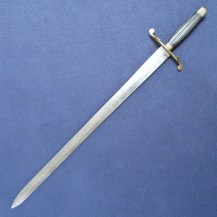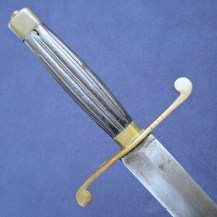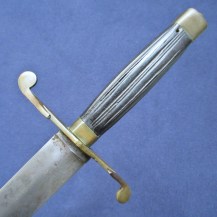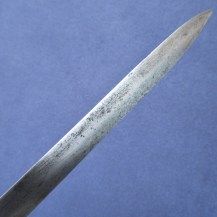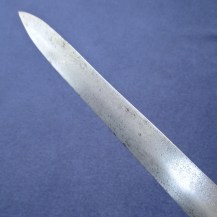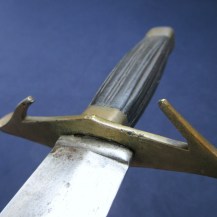English Circa 1800 Fighting Dirk
Double-edged, spear-pointed blade 18 inches in length, overall length 22¾ inches, diamond cross-section. Reeded ebony grip, flat square brass ‘pillow’ pommel, simple chamfered square brass ferrule and brass cross hilt with forward and reverse quillons and remnants of a side-ring.
The hilt and ferrule are both marked ‘XIII’, quite crudely struck.
This is an example of an early type of English officer’s dirk, carried by officers in both the Army and Navy from around 1770 until the 1820s. The lack of any uniform regulations during this period allowed officers the freedom to buy and carry weapons of their choice, leading to great variety in weaponry. Dirks were a form of dagger or long knife typically carried in addition to an officer’s full-size hanger or smallsword, used either as a backup weapon or held in the off-hand in the manner of a parrying dagger. Fighting examples such as this one tend to be simply constructed, probably quite inexpensive at the time, with little ornamentation but a relatively substantial blade. This example could be Army or Navy, one cannot tell from its plain features.
The blade has light patination and minor pitting in places. There is slight movement to the hilt, which appears to have at one time had a simple side-ring like those often found on contemporary swords – this has broken or been removed, leaving two spurs. The brass parts have a dark, even patina consistent with their age. A very small hole has been bored on each side of the grip near the pommel. The grip has minor handling wear and surface-level cracking, but remains sound and solidly mounted to the blade.
A very similar example is illustrated in Peter Tuite’s ‘British Naval Edged Weapons - An Overview’, in the American Society of Arms Collectors Bulletin, 86:37-57, with a shorter blade and steel mounts instead of brass, made by Mayfield of Dublin circa 1800.


